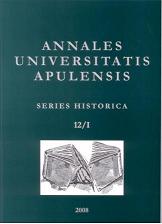Gravurile Triodului de la Buda din 1816
The engravings of the Triodyon of Buda (1816)
Author(s): Anca Elisabeta TataySubject(s): Cultural history
Published by: Editura Mega Print SRL
Keywords: xylograph; printing house; old Romanian book; Buda; art; iconography
Summary/Abstract: Religious and laic Romanian books were printed in the typography of Buda since 1780. It is to the leaders of the Transylvanian School that we owe the development of typography. We have to mention names, such as: Samuil Micu, Gheorghe Şincai, Petru Maior. They carried on their activity as censors or readers here. The Triodyon of Buda was printed in 1816 and is usually bound with the Strastnic. Both books are remarkable as far as the graphic art is concerned. They are decorated with title sheet, frontispieces, vignettes and illustrations. Some of them can be found in both books or in the same book more than once – none of them is signed. The present study offers an in-depth analysis of the graphical material that is part of the Triodyon of Buda, displays its artistic value, and determines the models that could have been the starting points in this respect. The graphic ornaments of the book are neither mentioned nor reproduced in Bibliografia românească veche (Old Romanian Bibliography) by Ioan Bianu, Nerva Hodoş and Dan Simonescu or in subsequent completions made by other researchers. Gh. Oprescu does not mention this printed work in his achievement, Grafica românească în secolul al XIX-lea (Romanian Graphics of the 19th Century), but Dragoş Morărescu reproduced the engraving Vameşul şi Fariseul (The Publican and the Pharisee) that is also part of the book. The title sheet and the two illustrations: The Publican and the Pharisee and The Crucifixion, were worked out by dint of previous models that appeared in Râmnic in the 18th century, while the frontispiece representing Jesus Christ is identical with that of a Viennese printed work from 1793. The book also contains some other frontispieces and a vignette that were obviously influenced by the Western art. The significance of the books printed in Buda, and their contribution to the building up of the Romanian culture is therefore emphasized again. The graphic material of these printed works demonstrates the intense circulation of the Romanian books that came out within and beyond the Carpathian area.
Journal: Annales Universitatis Apulensis Series Historica
- Issue Year: 12/2008
- Issue No: 2
- Page Range: 231-243
- Page Count: 13
- Language: Romanian
- Content File-PDF

